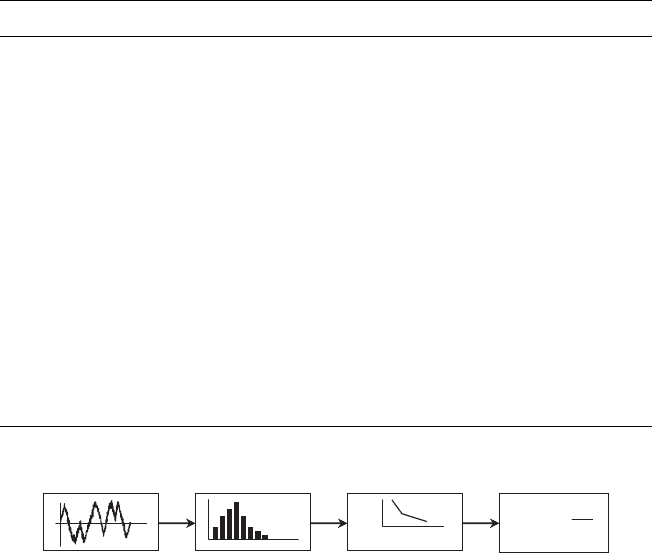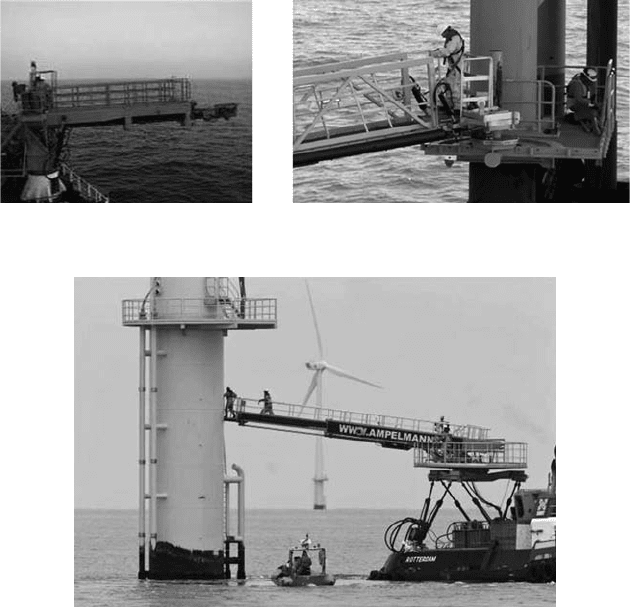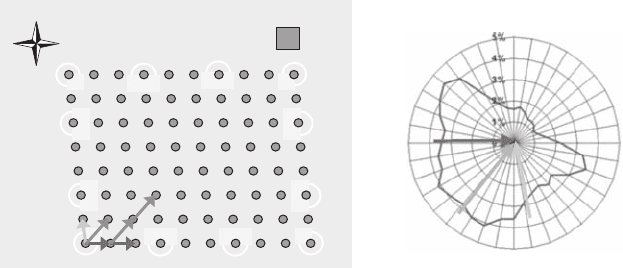Tong W. Wind Power Generation and Wind Turbine Design
Подождите немного. Документ загружается.


Design of Support Structures for Offshore Wind Turbines 585
continuous varying loads over time. For a fatigue check it is therefore vital to
know the following details:
environmental loads over the lifetime of the structure •
steel properties at the most severely loaded sections (typically: welds) •
fatigue resistance of the details of these welds: empirical S–N curves. •
The long-term environmental loads are usually gathered in tables listing the
simultaneous occurrence of wave height, period and direction, wind speed and
direction and potentially several other parameters. For the fatigue check of the
support structure the amount of data for a 20-year lifetime can accumulate to over
1000 load cases. To reduce these for the initial design stages, scatter diagrams are
used. Table 4 shows a typical scatter diagram for wave height and period.
Such a wave scatter diagram is available for every wind speed bin (0–2 m/s
wind, 2–4 m/s, 4–6). We then have the simultaneous occurrence of wave height,
period and wind speed in a 3D scatter diagram.
To calculate the fatigue of the structure, we ideally need to run all these load
cases through a wind turbine simulation program such as Bladed or Flex to
incorporate all wind, wave and structure interactions an fi nd the stress varia-
tions in each critical point of the structure. In the preliminary design stages, a
reduced amount of data can be used that represents the most commonly occur-
ring wind and wave conditions. Typically, the amount of data is reduced to 15
or 20 of these environmental states. An example for the Blyth turbines is shown
in Table 5 .
Table 4: Wave scatter diagram for H
s
and T
z
with occurrence in parts per thousand
for the OWEZ location.
H
s
(m) T
z
(s)
Sum
0–1 1–2 2–3 3–4 4–5 5–6 6–7 7–8
6.5–7.0 0.0
6.0–6.5 0.1 0.1
5.5–6.0 0.1 0.1 0.2
5.0–5.5 0.1 0.1 0.2
4.5–5.0 1 1.0
4.0–4.5 4 4.0
3.5–4.0 4 5 9.0
3.0–3.5 19 0.1 19.1
2.5–3.0 0.1 38 38.1
2.0–2.5 27 43 70.0
1.5–2.0 0.1 115 5 120.1
1.0–1.5 6 220 1 227.0
0.5–1.0 236 145 1 382.0
0.0–0.5 1 1 113 14 0.1 129.2
Sum 1.0 0.0 1.0 355.1 521.1 111.1 10.4 0.3 1000

586 Wind Power Generation and Wind Turbine Design
When the stress signal is determined for each location that needs to be checked,
the fatigue calculation can be performed. Figure 34 shows the calculation steps: the
stress history is converted to stress ranges via the rainfl ow counting method.
The stress ranges are then checked against the S – N curve for the detail under
consideration and the fatigue damage due to the load case is calculated using the
Miner sum.
When the Miner sum is determined for each load case, it is multiplied by the
percentage of occurrence during the design life of 20 years. The total fatigue dam-
age is then found by adding the damage of all individual load cases together.
Should a detail not pass the fatigue check, changing the wall thickness will
reduce the amount of stress and a re-calculation of the fatigue can be performed.
To check the full fatigue of a monopile design requires several hours of computa-
tion time with current industry standard software. New methods of calculating the
fatigue in the frequency domain show promising results and they have found their
way to preliminary design calculations.
Table 5: Summary of 15 environmental states for Blyth.
H
s
(m) T
z
(s) V
w
(m/s)
% of occurrence
1 0.25 2.0 5.0 20.47
2 0.25 5.2 4.9 3.73
3 0.25 4.0 11.8 21.76
4 0.25 5.6 15.7 3.85
5 0.25 5.8 20.6 1.00
6 0.75 3.4 6.7 8.62
7 0.75 5.3 5.8 13.25
8 0.75 5.5 11.7 5.58
9 1.25 5.2 8.8 10.66
10 1.25 8.0 8.5 1.25
11 1.75 6.0 9.9 4.83
12 1.75 6.7 16.2 0.55
13 2.4 6.8 12.8 3.54
14 3.4 7.8 14.5 0.77
15 3.3 9.7 18.7 0.14
100%
N
S
i
fat
i
i
n
D
N
=
∑
Miner sumS-N curveStress history
Stress range
histogram
Filter stress
ran
g
es
S
i
n
i
Figure 34 : Flowchart of fatigue calculation due to variable stress ranges using
S – N curve and Miner sum.
Design of Support Structures for Offshore Wind Turbines 587
5.8 Optimising
The design steps described in this section have been treated on a high level only.
The design process will involve several repetitions in which structural properties
change in one step and require checking in all other steps again. Furthermore,
some steps have not been treated here: the design of secondary steel and its impact
on support structure loads and stress concentrations; the drivability analysis of the
pile and the associated fatigue (the pile loses 25–30% of its fatigue resistance during
installation); the impact of scour, corrosion and marine growth, etcetera.
6 Design considerations
6.1 Offshore access
The majority of the maintenance activities that are required during the entire life-
time of an offshore wind farm consist of simple repairs rather than the replacement
of turbine parts. Therefore, the accessibility to be treated here will involve person-
nel and light equipment only. The accessibility of a wind turbine depends fi rst of
all on the chosen access method. In the offshore industry there are two means of
transportation used to reach offshore structures: helicopters and vessels.
6.1.1 Helicopters
Helicopters are used regularly to gain access to various offshore installations since
they provide a fast means of transportation for personnel and light equipment at cruise
speeds up to 250 km/h. Another big advantage of using helicopters is that both travel
and access operations are not limited by wave conditions. If an offshore structure is
equipped with a helicopter landing deck, the helicopter can land on this deck and pas-
sengers can safely board or exit the helicopter. However, mounting a landing deck on
an offshore wind turbine would be unpractical. Instead, a hoisting platform can be
placed on the turbine nacelle. The transfer of personnel from helicopter to turbine is
then achieved by having the helicopter hovering above the turbine and hoisting people
from the helicopter down to the platform on top of the turbine. Although this method is
fast, disadvantages are the high costs of operation and the fact that a hoisting platform
is required on each turbine. In addition, most exploiting parties are not eager to use this
method due to the risks involved using helicopters: in case of a crash, the risk of casu-
alties is high. In fact, the Horns Rev wind farm, located in the North Sea 14 km west
of Denmark, is the only wind farm where helicopter hoisting is applied as a means of
access. Furthermore, this method only allows transferring personnel with a very lim-
ited amount of tools and safe fl ying can be hampered by limited visibility and too large
wind speeds. The accessibility of a helicopter is therefore determined by the percentage
of the time that both wind speed and visibility are outside the restricted values.
6.1.2 Vessels
The use of vessels is a more cost-effi cient and probably safer way of accessing
offshore wind turbines than using helicopters. Currently, the most commonly used

588 Wind Power Generation and Wind Turbine Design
vessels for wind farm support are small vessels with lengths between 14 and 20 m,
with either a single or a twin hull shape, and a bow section that is designed for
access. Safe access is provided by intentionally creating frictional contact between
the vessel and a boat landing structure on and in order to have no vertical vessel
motions at the point of contact. A rubber bumper on the vessel bow forms this
contact point; the thrusters push the boat against the structure to create the friction.
The boat now pivots around the bumper and personnel can step from the vessel
bow onto the turbine ladder safely. This method is generally being used for main-
tenance visits and applied by different types of vessels as shown in Fig. 35 .
This ship-based access to offshore wind turbines is limited by wave conditions.
As wave conditions get rougher, ship motions will become lager and there is a
possibility that the vessel loses its contact with the boat landing. As a result, the
vessel can start moving relative to the offshore structure. In this situation, the
safety of the person accessing the turbine can no longer be guaranteed: the access
procedure is no longer safe. For this reason, access operations are limited to cer-
tain wave conditions. The general way of describing the limiting wave conditions
for access is by giving the limiting signifi cant wave height for an access method.
In wave conditions exceeding this limiting signifi cant wave height, the access
operation is considered too dangerous and will therefore not be performed.
6.1.3 Motion compensation systems: Ampelmann and OAS
The core of the problem when transferring people from a ship to a structure is that
the vessel moves with the waves and the structure is stationary. The development
of offshore wind sparked new innovations in this fi eld. Several systems have been
developed that compensate the wave motions partially or fully to remove the rela-
tive motion problem. The Offshore Access System is a hydraulic gangway that
compensates the heave motion while connecting to the offshore structure. The off-
shore structure needs to be equipped with a landing station where the OAS grabs
onto. As soon as the contact is made, the active compensation is switched off and
the gangway hinges passively on both ends, as shown in Fig. 36 .
The Ampelmann follows a different approach: it cancels all motions in the 6 degrees
of freedom (surge, sway, heave, roll, pitch, yaw) to achieve a completely stationary
platform. A gangway is then extended that is lightly pressed against the structure to
allow quick and safe access. The additional advantage is that no landing station is
(a)(b)
(c)
Figure 35: Ship-based access to offshore wind turbines. Ships used: (a) WindCat;
(b) Aaryan; (c) Moidart.

Design of Support Structures for Offshore Wind Turbines 589
needed, saving steel on each single support structure. The Ampelmann is shown in
Fig. 37 .
Both systems allow safe transfer in sea states up to H
s
= 2.5 m, enabling main-
tenance crews to access the turbines over 90% of the year.
6.2 Offshore wind farm aspects
In this chapter the design of support structures was the main theme. The support
structures and their turbines make up the offshore wind farm. The design of the
offshore wind farm as a whole also has impact on the single support structures.
The most pronounced items are summarised here.
6.2.1 Wind farm layout
The offshore wind farm layout is fi rst and foremost determined by the consented
stretch of seabed available for the farm. But within this area, optimisation on
farm level is possible. The fi rst design goal is to place the turbines close to each
other to limit cable length, and as far apart as possible to increase power capture.
Figure 36: Access to offshore structure with OAS.
Figure 37 : Ampelmann system for accessing offshore wind turbines.

590 Wind Power Generation and Wind Turbine Design
Because the wind fl ow offshore is less turbulent, the mixing of the air behind
the turbine (which has been slowed down due to the extraction of energy) takes
longer to regain strength from the undisturbed wind around it. This means that
turbines need to be placed further apart in offshore wind farms compared to
onshore where turbulence intensity is higher. The rule of thumb is to place tur-
bines at least seven times the rotor diameter apart. Smart layout confi gurations
help increase the distance between the turbine in the governing wind direction
to 10D or more, while maintaining the 7D minimum distance to make sure the
cable length does not increase too much. Figure 38 shows such a layout with the
wind rose on site.
6.2.2 Electrical infrastructure
The offshore wind power needs to be transported to the electricity grid. Within
the offshore wind farm, in-fi eld cables connect the turbines to each other. For
most larger offshore wind farms (>100 MW) a transformer station is normally
used. Here all in-fi eld string cables come together. The total power is gathered
and the voltage is increased to reduce losses to shore along the “shore connec-
tion cable”. Typical voltages in fi elds are order of magnitude 33 kV, to shore
50 kV.
The in-fi eld cable routing has infl uence on the design of the support struc-
tures: to most turbines two J-tubes will guide the incoming and outgoing cable,
requiring secondary steel attachments that can add signifi cant hydrodynamic
loads. For installation purposes it can be very benefi cial to choose a simple grid
type of layout. Should a “star grid” or other, non-regular pattern be chosen,
maintenance vessels may damage them in later years when there is confusion
about the exact location.
6.2.3 The support structure in the offshore wind farm
Offshore wind farms are complex systems placed in a harsh environment, designed
to operate on their own for large periods of time. The support structure is an integral
w
N
N
T
Figure 38 : Wind farm layout with the wind rose on site.
Design of Support Structures for Offshore Wind Turbines 591
part of these systems and should be treated as such. The design steps depicted in
this chapter give a fi rst rough guide to fi nding an optimised solution. The detailed
design of the support structure requires intense cooperation between the different
disciplines involved in offshore wind farm design and construction. Only then can
the true potential be unleashed of the force we know as “offshore wind”.
References
[ 1] Ferguson, M.C., et al. (ed), Opti-OWECS fi nal report Vol. 4: a typical design
solution for an offshore wind energy conversion system, Institute for Wind
Energy, Delft University of Technology, 1998.
[ 2] Germanischer Lloyd, Rules and Guidelines for the Design of Offshore Wind
turbines , Hamburg, Germany, 2004.
[3] DNV, Design of offshore wind turbine structures , Det Norske Veritas, DNV-
OS-J101, 2004.
[4] Tempel, J. van der, Design of support structures for offshore wind turbines,
PhD. Thesis, Delft University of Technology, Section Offshore Engineering,
2006.
[ 5] Verruijt, A., Offshore Soil Mechanics , Delft University of Technology, 1998.
[6] API, Recommended Practice for Planning, Design and Constructing Fixed
Offshore Platforms – Working Stress Design , American Petroleum Institute,
21st edition, 2000.
This page intentionally left blank
PART IV
I
MPORTANT ISSUES IN WIND TURBINE DESIGN
This page intentionally left blank
